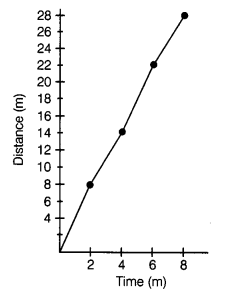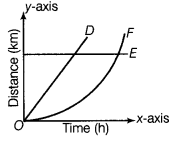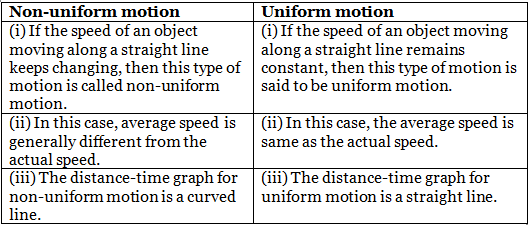Class 7 Science Chapter 9 Question Answers - Motion and Time
Q1. Differentiate between a uniform and non-uniform motion.
Ans: When a body travels equal distance in an equal interval of time, then the body is said to be in a uniform motion.
When a body travels unequal distance in an equal interval of time, then the body is said to be in non-uniform motion.
Q2. Briefly mention how many types of motion are there. Also, name all of them.
Ans: Different types of motion are there and they can be named as follows
- Periodic motion
- Rolling motion
- Rotatory motion
- Oscillatory and vibratory motions
- Translatory motion
Q3. With the help of the data given in the following table, show graphically the relationship between the diameter and circumference of a circle.
Ans: With the help of a given data in a tabular form, the graph can be obtained by taking diameter of the circle on the x-axis and the circumference on y-axis. On x-axis, 1 cm diameter is shown by 1 cm and on the y-axis, 3 cm of circumference is shown by 1 cm.
Q4. Starting from A, Paheli moves along a rectangular path ABCD as shown in figure. She takes 2 min to travel each side. Plot a distance-time graph and explain whether the motion is uniform or non-uniform.
Ans: Since, the distance covered per unit time for the entire distance covered is not the same, the motion is a non-uniform motion.
Q5. The following distance-time graph of three objects (D, E and F) are given (see figure given alongside). What can you say about the motion of the objects?
Ans: Since, the distance-time graph of an object D is a straight line therefore, its motion is uniform. Also here, we can see that the distance-time graph of object E is parallel to x-axis (time-axis), therefore object E is at rest.
As, the distance-time graph of object F is a curved line, therefore the object C is moving with a non-uniform speed and its motion is non-uniform.
Q6. The following figure shows the distance-time graph for the motion of two objects D and E. Which one of them is moving slower? Ans: After studying the figure given alongside, D or E is moving slower as the slope of distance-time graph of E is less than that of graph D.
Ans: After studying the figure given alongside, D or E is moving slower as the slope of distance-time graph of E is less than that of graph D.
Q7. The following figure shows the distance-time graph for the motion of two vehicles (C and D). At what time and distance (from the starting point), they will cross each other.
Ans: Firstly, draw perpendicular lines from point E on x-axis and y-axis. The two vehicles (C and D) will meet (or cross) each other at 5:00 PM and after travelling a distance of 4 km.
The two vehicles (C and D) will meet (or cross) each other at 5:00 PM and after travelling a distance of 4 km.
Q8. Explain by giving example that how can we choose a suitable scale.
Ans: While choosing the most suitable scale for drawing a graph, we should keep the following points in mind
(i) The difference between the highest and lowest values of each quantity.
(ii) The intermediate values of each quantity so that with the scale chosen, it is easy to mark the values on the graph.
(iii) To utilise the maximum part of the paper on which the graph is to be drawn, assume that we have a graph paper of size 25 cm x 25 cm and we have to accommodate following data: Since, one of the scales will be
Since, one of the scales will be
Distance 5 km = 1 cm and Time 6 min = 1 cm
Q9. The given data regarding the motion of two different objects C and D is in a tabular form. Check them carefully and state whether the motion of the objects is uniform or non-uniform.
Ans: We can check the motion of the objects C and D by plotting the distance-time graph for the two objects.
Graph the object C on x-axis
Scale 1 cm = 15 min and on y-axis 1 cm = 10 m
Since, the distance-time graph of the object C is a straight line. Therefore, its motion is uniform.
Graph of object D
Scale On x-axis, 1 cm = 15 min, On y-axis 1 cm=5m Since, the distance-time graph of the object D is not a straight line, therefore, its motion is non-uniform.
Since, the distance-time graph of the object D is not a straight line, therefore, its motion is non-uniform.
Q10. Differentiate between slow and fast objects.
Ans: An object which takes longer time to cover a certain distance is called slow whereas another object which takes a shorter time to cover the same distance is called fast.
Q11. What is motion? Describe briefly.
Ans: An object that is moving with respect to time and another body is said to be in motion. Motion is measured as the distance covered by an object in a specific interval of time.
Q12. Anshika takes 15 minutes from her house to reach her school on bicycle the distance between her house and the school.
Ans: Time taken = 15 min.
Speed = 2 m/s
Distance = Speed × time
= 15 × 60 × 2 = 1800 m
Thus, the distance between Anshika’s house and her school is 1800 m.
Q13. What are the factors on which time period of a pendulum depends?
Ans: Following are the factors on which time period of a pendulum depends:
- Length of the string of the pendulum.
- Acceleration due to gravity.
Q14. State the difference between uniform motion and non-uniform motion.
Ans:
|
111 videos|246 docs|28 tests
|

|
Explore Courses for Class 7 exam
|

|

















